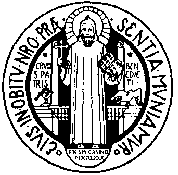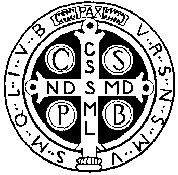
On the front of the St. Benedict Medal
On the front of this medal, St. Benedict is hold the Book of Rules for
Monasteries in his left hand and The Cross, the Christian's symbol of
salvation, in his right hand.
Right below the Cross Benedict is holding, is the poisoned
cup, shattered when he made the sign of the cross over it.
Right below
the Book of Rules for Monasteries Benedict is holding, is a
raven about to carry away a loaf of poisoned bread that a jealous enemy
had sent to St. Benedict.
In very small type, above the cup and the
raven are the Latin words:
C. S. P. B.
Crux S. Patris Benedicti
The Cross of our holy father Benedict.
On the outside rim of the medal,
encircling the figure of Benedict, are the Latin words:
Eius in obitu nostro praesentia muniamur!
May we be strengthened by his presence in the hour of our death!
Eius in obitu nostro prae— on the
Cross side
sentia muniamur!— on the Book of
Rules for Monasteries side
Benedictines have always regarded St. Benedict as a special patron of
a happy death. He himself died in the chapel at Montecassino while standing
with his arms raised up to heaven, supported by the brothers of the monastery,
shortly after St. Benedict had received Holy Communion.
In very small type below St. Benedict's feet we
read:
ex SM Casino MDCCCLXXX —from holy Monte Cassino, 1880.
This is
the medal struck to commemorate the 1400th anniversary of the birth of
Saint Benedict.
On the reverse side of the St. Benedict Medal

On the back of the medal, the cross is dominant. On the arms of the
cross are the initial letters of a rhythmic Latin prayer.
On the
vertical portion of the Cross:
Crux sacra
sit mihi lux!
May the holy cross be my light!
On the horizontal portion of the Cross:
Nunquam draco sit mihi dux!
May the dragon never be my guide!
(May the holy cross be my light!
May the dragon never be my guide!).
In the angles of the cross, the letters C S P B stand for Crux Sancti
Patris Benedicti (The cross of our holy father Benedict).
Above the cross is the word pax (peace), that has been a Benedictine
motto for centuries.
On the outside rim of the back of the medal
The letter:
On YOUR right side: V R S — N S M V
Vade retro Satana! (V R S) Nunquam suade mihi vana! (N S M V)
Begone Satan! (V R S) Never tempt me with your vanities! (N S M V)
On YOUR left side: S M Q L — I V B
Sunt mala quae libas. (S M Q L) Ipse venena bibas! (I V B)
What you offer me is evil. (S M Q L) Drink the poison yourself! (I V B)
Together: V R S N S M V S M Q L I V B
Vade retro Satana! Nunquam suade mihi vana! Sunt mala quae libas. Ipse
venena bibas!
Begone Satan! Never tempt me with your vanities! What
you offer me is evil. Drink the poison yourself!
— a Latin prayer
of exorcism against Satan. |
